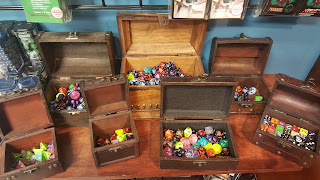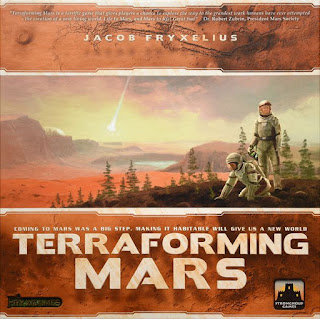Terraforming Mars, by Stronghold Games, is an economic hand
and resource management game about terraforming Mars over 5-15
generations. In order to make the planet
livable, your and some friend's corporations will utilize all of humanity's
resources on patents for projects that will raise the oxygen, increase the
temperature, and place oceans on the face of Mars, as well as build cities,
raise animals, and potentially crash a moon in to the planet (just Deimos, not
Phobos).
We have mostly played the game co-op, but we have had the game
for less than a month and we have played 36 co-op games. The game is primarily a competitive game, but
it does have solo rules, and we found these easily adapted to co-op. We have both played competitive as well, and
we'll make sure to talk about how our opinions differ on each aspect of the
game.
First Impressions
Gabe (Green): I was
intrigued by the resource management of this game instantly, and the way you
buy patents (cards) before you play them was an interesting insight to the
economic aspect of the value of a dollar today versus a dollar tomorrow. I can spend lots of money to hold on to more
patents, but then I won't be able to afford to enact any of them; or I can
spend less money, but then if I have 3 extra Space Bucks at the end of the
turn, I'll regret not keeping a really powerful card I ditched and could've
saved for later. The board itself didn't
do much for me originally, but I've grown to appreciate the tile placement
aspect of the game.
Ashley (Blue): At
first, I thought the game was so-so, but my first experience was competitive
and I prefer co-op games. After getting
a lot of co-op games under my belt, playing competitive again was much more
enjoyable. In the first game I played
Saturn Systems, which exploits outer space cards and uses Titanium as its
primary resource. This steered me
towards certain cards and towards prioritizing certain goals, which helped me
pick cards, but it also does not directly lend itself towards terraforming the
planet, which made me try to get victory points in other ways.
Favorite Part
Ashley: The game is
easy to learn, but it has plenty of variety in it. For the first 20 or so games, you are always
learning something new and finding more depth.
For example, the microorganisms are a little complex for the first
couple games, but they aren't necessary either, and you can just not play those
cards. Early on, you are just focusing
on how to terraform, especially in co-op where you have a time limit. As you play more games, you can delve into
strategies that are more complex and net you more victory points.
Gabe: One of my bigger
fears the first time I played the game is that there are only just over 200
cards, and when you play with 5 people you see the entire deck. I was worried that the gameplay would get
repetitive and boring after replaying it.
I can soundly say that after playing the game over 40 times (not
counting solo plays), I've never had a game feel the exact same twice. A single card's value changes so much based
on how early or late the game is, what your corporation's power is, what your
other cards are, what your resources are, and how you are personally trying to
score points that game, that even getting the exact same card in multiple
games, I will value it differently in each situation. In any given game you see at least 40 cards
that you can have a unique analysis and value on, making every game feel
different, whether I'm exploring a strategy in the game I rarely try or if I'm
going with one of my staple strategies that I always enjoy.
Worst Bits
Ashley and Gabe: The
production quality of the game is definitely a problem. The pieces that represent the oceans,
forests, and cities feel cheap and the paper over the cardboard has started to
peel on some (which is especially bad for the oceans, because you use all 9
oceans every game), and the board has some writing where the board folds that
becomes creased and illegible after being used.
The writing itself is not a large factor; it is mostly flavor, telling
you what the names of those regions of Mars are, but it still feels bad to have
a product we enjoy so much and put so much time in to that doesn't hold up even
after a month. The player boards that
come with the game do not hold the pieces of the game very well, and are made
out of the flimsiest of cardstock. We
had to solve this problem by buying overlays, which there are a variety of
kinds available if you google “Terraforming Mars player board overlays”, and
those have been worth their weight in Space Bucks. Also, there will be a double-sided game board
as the new map for the first expansion; while I wouldn't expect the product
quality to necessarily improve, more boards will mean we're using each board less.

Gameplay
Ashley: The co-op feels
like a race against time. For 2 players,
you have 10 generations to try to terraform the planet, and it makes an hour of
real life go by very quickly. There's an
exponential effect: it is not uncommon
for the first four or five turns to have very little happening as you're
getting your systems online. However,
once you get started on turns six or seven, a game that seemed unwinnable can
suddenly turn into a solid victory. It's
especially nice to combine resources by drafting out the cards, so that each
player can specialize in either heat or plant production and really feel like
they own their half of the gameplay.
Gabe: The competitive
gameplay is a whole different beast. It
is surprisingly more relaxing, as there is no inherent turn limit, and you can
sit back and play around with different engines. Since I spend so much time of co-op trying to
actively terraform the planet, when I switch to competitive I try to use
strategies in which I minimize actual terraforming for points and just try to
get points off of the greedy victory point cards. Once you've played the game enough to get a
glimpse of all of the strategies, in a competitive game you can pick any one
you like and do well with it. The cards
themselves are very well balanced, and most of the corporations seem like
they're on an even playing field. The
actual terraforming of the planet can become a much smaller aspect of the game,
as everyone at the table is busy exploring their own corner of the gameplay.
Overall
Ashley and Gabe: Clearly
this game is a winner in our books, and we've gotten a lot of play out of
it. Our enjoyment is not diminishing,
and we don't feel like we're almost “over” this board game and on to the next
game. Another board game might take its
spot later, but we haven't played that game yet. To compare it to the other big names of 2016,
being Scythe and Great Western Trail, Terraforming Mars is the easiest to teach
and the easiest to set up, and even if you play competitive, it does not feel
as “in-your-face” as some of the others.
I, Gabe, enjoy all three, and am not sure Terraforming Mars is my
favorite, but it is certainly the easiest for me to break out and play with
Ashley in a timely manner, so that adds a lot of value right there.
A few recommendations on gameplay: the game has a “starter mode” with “beginner
corporations”; this mode should be ignored.
If you play with the normal corporations, they each have special powers
and will steer the players in certain directions, whereas the beginner
corporations open the new players up to being competent at everything without
being great at anything, and will have them wanting to play too many cards and
not focus on any strategy. Also, the
game has a drafting variant; we strongly suggest not using this when teaching
players for the very first time, and using it every other game after that. While players are learning the cards and how
to value patents, drafting adds a lot of time and complexity, but after one
game of understanding the mechanics players should be better suited to make
good drafting decisions. Finally, for
our custom co-op mode, we follow the rules in the rulebook for Solo, with a few
minor exceptions. We put the turn limit
at 10 turns instead of 14, and we also draft each hand (including the first 10). We've been keeping track of all of our games
with the turn we finished and our scores, and we consider a Turn 9 win to be
superior to any Turn 10 win, regardless of how many points we scored.
Gabe Schmidt (Green
player) and Ashley Grubb (Blue player) are a power board gaming couple. They enjoy how much board games give them
time to think and play together instead of staring at a screen in the same room
as each other. We're frequent fliers at Huscarl
Hobbies and Games, and if you have any questions for us, feel free to contact
us at profparm@gmail.com.














